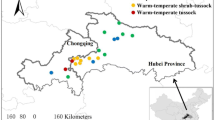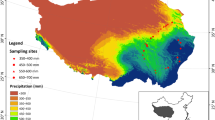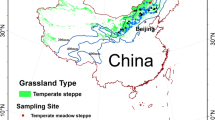Abstract
Purpose
Soil organic carbon (SOC) dynamics are central to understanding the effects of environmental change on the carbon cycle of ecosystems. Vegetation and soil stable carbon isotope composition (δ13C), especially the difference of δ13C between surface soils and source vegetation (Δδ13C), can provide useful information about the SOC dynamics. The variations and patterns of vegetation and soil δ13C and Δδ13C along climatic and edaphic gradients were analyzed to improve the understanding of SOC dynamics in temperate grassland ecosystems.
Materials and methods
Soil and plant samples were collected along climatic and edaphic gradients. Meteorological data were extracted from a regional climate database, which was spatially interpolated based on the records at 107 climatic stations located in Inner Mongolia. δ13C, carbon and nitrogen contents of soil and plant, soil pH, soil clay, silt, and sand contents were determined. Δδ13C and soil C:N were calculated. The integrative effects of these factors were further estimated using stepwise regression, redundancy analysis (RDA) and T value biplots.
Results and discussion
As expected, soil δ13C was positively related to vegetation δ13C, and higher than the vegetation δ13C. Vegetation and soil δ13C and Δδ13C were all related to growing season precipitation (GSP) and growing season temperature (GST). However, when climatic and edaphic factors were considered together, vegetation δ13C was positively related to GST and soil C:N, soil δ13C was positively related only to GST, and Δδ13C was negatively related only to soil C:N. Unlike previous research conducted at the species level which only included C3 species, GST, instead of precipitation, was the dominant controlling factor of vegetation δ13C.
Conclusions
GST influences vegetation δ13C mainly through its effect on relative abundance of C4 plants. Soil C:N rather than climatic factors is the dominant controlling factor of SOC decomposition, and the effects of climatic factors on SOC decomposition are indirect and induced by their effects on soil C:N through influencing species composition and plant C:N. Measuring vegetation δ13C, soil δ13C, and △δ13C simultaneously is necessary to comprehensively understand how environmental changes influence ecosystem carbon cycles.





Similar content being viewed by others
References
Acton P, Fox J, Campbell E, Rowe H, Wilkinson M (2013) Carbon isotopes for estimating soil decomposition and physical mixing in well-drained forest soils. J Geophys Res Biogeosci 118:1532–1545
Angelo CL, Pau S (2015) Root biomass and soil δ13C in C3 and C4 grasslands along a precipitation gradient. Plant Ecol 216:615–627
Auerswald K, Wittmer MHOM, Bai Y, Yang H, Taube F, Susenbeth A, Schnyder H (2012) C4 abundance in an Inner Mongolia grassland system is driven by temperature–moisture interaction, not grazing pressure. Basic Appl Ecol 13:67–75
Averill C (2014) Mycorrhiza-mediated competition between plants and decomposers drives soil carbon storage. Nature 505:543–545
Bai E, Boutton TW, Liu F, Ben Wu X, Hallmark CT, Archer SR (2012) Spatial variation of soil δ13C and its relation to carbon input and soil texture in a subtropical lowland woodland. Soil Biol Biochem 44:102–112
Bao S (2005) Agricultural and chemistry analysis of soil. Agriculture Press, Beijing
Berendse F, Van Breemen N, Rydin H, Buttler A, Heijmans M, Hoosbeek MR, Lee JA, Mitchell E, Saarinen T, Vasander H (2001) Raised atmospheric CO2 levels and increased N deposition cause shifts in plant species composition and production in Sphagnum bogs. Glob Chang Biol 7:591–598
Campbell JE, Fox JF, Davis CM, Rowe HD, Thompson N (2009) Carbon and nitrogen isotopic measurements from southern Appalachian soils: assessing soil carbon sequestration under climate and land-use variation. J Environ Eng 135:439–448
Chen SP, Bai YF, Lin GH, Huang JH, Han XG (2007) Variations in δ13C values among major plant community types in the Xilin River Basin, Inner Mongolia, China. Aust J Bot 55:48–54
Cheng X, Luo Y, Xu X, Zhang Q (2011) Soil organic matter dynamics in a North America tallgrass prairie after 9 yr of experimental warming. Biogeosciences 8:1487–1498
Department of Animal Husbandry and Veterinary, Institute of Grasslands, Chinese Academy of Agricultural Sciences (DAHV), Commission for Integrated Survey of Natural Resources, Chinese Academy of Sciences (CISNR) (1996) Rangeland resources of China. China Agricultural Science and Technology Press, Beijing
Ehleringer JR, Buchmann N, Flanagan LB (2000) Carbon isotope ratios in belowground carbon cycle processes. Ecol Appl 10:412–422
Feng ZD, Wang LX, Ji YH, Guo LL, Lee XQ, Dworkin SI (2008) Climatic dependency of soil organic carbon isotopic composition along the S–N transect from 34°N to 52°N in central-East Asia. Palaeogeogr Palaeoclimatol Palaeoecol 257:335–343
Fu Y, Yu Y, Yao H (2011) Changes of soil organic carbon of grassland in the Xilinguole, Inner Mongolia from 2000 to 2007. Pratacult Sci 28:1589–1597
Garten CT, Cooper LW, Post WM, Hanson PJ (2000) Climate controls on forest soil C isotope ratios in the southern Appalachian Mountains. Ecology 81:1108–1119
Graven H, Allison CE, Etheridge DM, Hammer S, Keeling RF, Levin I, Meijer HA, Rubino M, Tans PP, Trudinger CM (2017) Compiled records of carbon isotopes in atmospheric CO2 for historical simulations in CMIP6. Geosci Model Dev 10:4405–4417
Kirschbaum MUF (2000) Will changes in soil organic carbon act as a positive or negative feedback on global warming? Biogeochemistry 48:21–51
Lee X, Feng Z, Guo L, Wang L, Jin L, Huang Y, Chopping M, Huang D, Jiang W, Jiang Q (2005) Carbon isotope of bulk organic matter: a proxy for precipitation in the arid and semiarid Central East Asia. Glob Biogeochem Cycles 19:2833–2845
Lin X, Zhang Z, Wang S, Hu Y, Xu G, Luo C, Chang X, Duan J, Lin Q, Xu B (2011) Response of ecosystem respiration to warming and grazing during the growing seasons in the alpine meadow on the Tibetan Plateau. Agric For Meteorol 151:792–802
O'Leary M (1981) Carbon isotope fractionation in plants. Phytochemistry 20:553–567
Percival HJ, Parfitt RL, Scott NA (2000) Factors controlling soil carbon levels in New Zealand grasslands: is clay content important? Soil Sci Soc Am J 64:1623–1630
Peri PL, Ladd B, Pepper DA, Bonser SP, Laffan SW, Amelung W (2012) Carbon (δ13C) and nitrogen (δ15N) stable isotope composition in plant and soil in southern Patagonia’s native forests. Glob Chang Biol 18:311–321
Powers JS, Schlesinger WH (2002) Geographic and vertical patterns of stable carbon isotopes in tropical rain forest soils of Costa Rica. Geoderma 109:141–160
Revelle R, Suess HE (1957) Carbon dioxide exchange between atmosphere and ocean and the question of an increase of atmospheric CO2 during the past decades. Tellus 9:18–27
Sanderman J, Amundson RG, Baldocchi DD (2003) Application of eddy covariance measurements to the temperature dependence of soil organic matter mean residence time. Glob Biogeochem Cycles 17:193–228
Scharlemann JP, Tanner EV, Hiederer R, Kapos V (2014) Global soil carbon: understanding and managing the largest terrestrial carbon pool. Carbon Manag 5:81–91
Schimel J, Schaeffer SM (2012) Microbial control over carbon cycling in soil. Front Microbiol 3:348
Schimel DS, Braswell BH, Holland EA, Mckeown R, Ojima DS, Painter TH, Parton WJ, Townsend AR (1994) Climatic, edaphic, and biotic controls over storage and turnover of carbon in soils. Glob Biogeochem Cycles 8:279–294
Spain AV (1990) Influence of environmental conditions and some soil chemical properties on the carbon and nitrogen contents of some tropical Australian rainforest soils. Aust J Soil Res 28:825–839
Van Groenigen KJ, Qi X, Osenberg CW, Luo Y, Hungate BA (2014) Faster decomposition under increased atmospheric CO2 limits soil carbon storage. Science 344:508–509
Waldrop MP, Zak DR, Sinsabaugh RL, Gallo M, Lauber C (2004) Nitrogen deposition modifies soil carbon storage through changes in microbial enzymatic activity. Ecol Appl 14:1172–1177
Wang S, Fan J, Song M, Yu G, Zhou L, Liu J, Zhong H, Gao L, Hu Z, Wu W (2013) Patterns of SOC and soil 13C and their relations to climatic factors and soil characteristics on the Qinghai–Tibetan Plateau. Plant Soil 363:243–255
Wang G, Jia Y, Wei L (2015) Effects of environmental and biotic factors on carbon isotopic fractionation during decomposition of soil organic matter. Sci Rep 5:11043
Wang C, Houlton BZ, Liu D, Hou J, Cheng W, Bai E (2018) Stable isotopic constraints on global soil organic carbon turnover. Biogeosciences 15:987–995
Wittmer M, Auerswald K, Tungalag R, Bai YF, Schaufele R, Schnyder H (2008) Carbon isotope discrimination of C3 vegetation in Central Asian grassland as related to long-term and short-term precipitation patterns. Biogeosciences 5:913–924
Wittmer M, Auerswald K, Bai YF, Schaufele R, Schnyder H (2010) Changes in the abundance of C3/C4 species of Inner Mongolia grassland: evidence from isotopic composition of soil and vegetation. Glob Chang Biol 16:605–616
Wynn JG, Bird MI (2008) Environmental controls on the stable carbon isotopic composition of soil organic carbon: implications for modelling the distribution of C3 and C4 plants, Australia. Tellus Ser B-chem Phys Meteorol 60:604–621
Wynn JG, Bird MI, Lins V, Emilie GC, John C, Berry SL (2006) Continental-scale measurement of the soil organic carbon pool with climatic, edaphic, and biotic controls. Glob Biogeochem Cycles 20:630–637
Xu X, Shi Z, Li D, Rey A, Ruan H, Craine JM, Liang J, Zhou J, Luo Y (2016) Soil properties control decomposition of soil organic carbon: results from data-assimilation analysis. Geoderma 262:235–242
Yang Y, Ji C, Chen L, Ding J, Cheng X, Robinson D (2015) Edaphic rather than climatic controls over 13C enrichment between soil and vegetation in alpine grasslands on the Tibetan Plateau. Funct Ecol 29:839–848
Zheng S, Shangguan Z (2007) Spatial patterns of leaf nutrient traits of the plants in the loess plateau of China. Trees 21:357–370
Zhou YC, Cheng XL, Fan JW, XU XY (2016) Spatial pattern of foliar δ13C in C3-dominated grasslands and its responses to climatic factors in Inner Mongolia, China. J Northeastern Univ (Nat Sci) 37:273–279
Acknowledgements
We thank Hongli Zhang for her assistance with field sampling and laboratory analyses.
Funding
The study was supported by the National Natural Science Foundation of China (No. 31400413); the Fundamental Research Funds for the Central Universities of China (No. N130301001, N160102001); the Doctoral Startup Foundation of Liaoning Province (No. 20141017); and the Visiting Scholar Program of China Scholarship Council (No. 201706085003).
Author information
Authors and Affiliations
Corresponding author
Additional information
Responsible editor: Zhihong Xu
Publisher’s note
Springer Nature remains neutral with regard to jurisdictional claims in published maps and institutional affiliations.
Electronic supplementary material
Fig. A1
Frequency distribution of soil and vegetation δ13C values from 29 temperate grassland sites on the Xilingele League, Inner Mongolia, China (DOCX 63 kb)
Fig. A2
Relationships of soil δ13C, vegetation δ13C and △δ13C with MAT and MAP in temperate grasslands on the Xilingele League, Inner Mongolia, China. MAT, mean annual temperature; MAP, mean annual precipitation (DOCX 107 kb)
Fig. A3
Relationships of soil δ13C, vegetation δ13C and △δ13C with soil texture in temperate grasslands on the Xilingele League, Inner Mongolia, China (DOCX 74 kb)
ESM 1
(DOCX 18 kb)
Rights and permissions
About this article
Cite this article
Zhou, Y., Zhang, W., Cheng, X. et al. Factors affecting 13C enrichment of vegetation and soil in temperate grasslands in Inner Mongolia, China. J Soils Sediments 19, 2190–2199 (2019). https://doi.org/10.1007/s11368-019-02248-z
Received:
Accepted:
Published:
Issue Date:
DOI: https://doi.org/10.1007/s11368-019-02248-z




